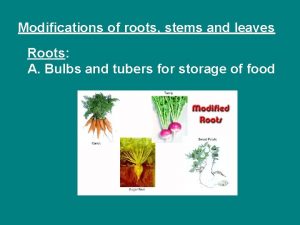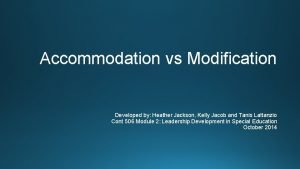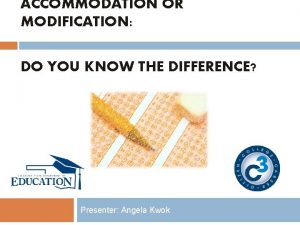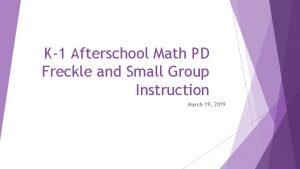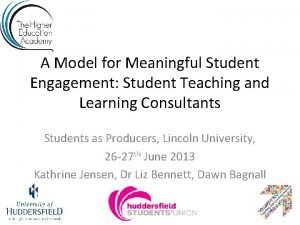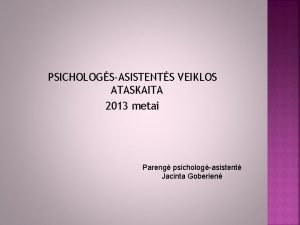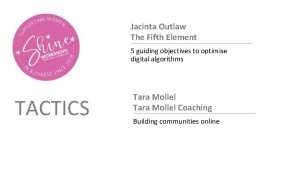Differential Teaching Modifications To Teaching Overview Jacinta Student






























- Slides: 30

Differential Teaching Modifications To Teaching

Overview • Jacinta. Student 1: low literacy NEP Student 2: abusive history, low literacy and numeracy • Danni – Student 3: Asperger’s syndrome (Autism spectrum) • Isabelle – Student 4: Dyscalculia and Dyslexia Student 5: Lower learning age Student 6: Government care facilities

Case Study: 1 • Student: Eric Banner • Year: 9 • Issue: Low literacy and inconsistent school attendance • School Context: attends a small country school, in a class of 17 students varying skill levels

Case Study: 1 • Advised that Eric has an NEP in place • Because of his poor literacy skills • Tasks and assessment need to be modified • Or extra assistance given • Eric struggles socially he doesn’t ‘fit in’

Case Study: 1 • NEP details: • The schools responsibilities for meeting Eric’s learning needs • His progress and achievements • His needs in relation to the curriculum • The accommodations that can be made with the existing resources • Consideration of the preferences of the student and parents • Any health and safety issues

Case Study: 1 • Apart of Eric’s NEP procedures put in place to help him through his schooling • Specifically in science the modifications made were: o Modified marking of assignments and tests o Additional assistance once the task has been set o Group work o Practical work

Case Study: 1 Modified Marking • When assessing Eric’s work we are looking for a basic level of understanding • e. g. understanding the aim of the experiment and recording observations rather than in-depth an analysis of the data Excerpt from Solar Oven Assignment: Your solar oven Design a solar oven that you can make in a double lesson. With a labelled diagram (showing the materials used), explain the choice in these materials and how your solar oven works. Labelled Diagram:

Case Study: 1 • Due to Eric’s continuing absences he is often not there to guide through lessons • He therefore has trouble with homework • Contacting parents is important • Making other time for Eric to get help, morning homegroup time • Interesting lessons

Case Study: 2 • Student: Emma Watson • Year: 8 • Issue: very low literacy and numeracy skills, past abusive history • School Context: attends a high school in the suburbs

Case Study: 2 • Emma is in an alternative numeracy and literacy class • But in main stream science classes • Makes science very diverse class with a range of abilities • Important to differentiate teaching to encompass the entire class

Case Study: 2 • It is important to have a good relation ship with Emma and her caregivers • Emma should feel safe to chat or disclose any information - Maslow Hierarchy of Needs • She responds well to praise, loves to be listened to and responds well to lessons on animals • By attending to these needs Emma can be more successful in class

Case Study: 2 • Because of Emma’s low literacy skills she requires extra aid during class especially in science where literacy skills are taken for granted • Giving Emma the task in small chunks allows her to succeed before moving on • Reading through Emma’s work before she moves on to the next part • Asking Emma to verbally explain concepts instead writing

Case Study: 2 • Emma responds well to practical lessons • Therefore demonstrations and practicals are used to maintain interest and to promote learning • E. g. teaching particle theory outside • Learning about atoms an molecules by building them • Drawing the structures within a cell Year 8’s learning the structure of graphite

Case Study: 3 • Student: Brad Pitt • Year: 10 • Issue: Asperger's syndrome or Austism Spectrum Disorder (ASD) • School Context: attends a regional country school, in a class of 32 students of varying skill levels

Case Study: 3 • Advised that Brad has mild asperger’s • Social skills appear unaffected, although he does seem to interact more easily with adults than other students • Very verbal, and can be a source of distraction • Go to topic of interest – mining • Sometimes displays nervous eye ticks • Prefers routines, often advised me of when I was doing something differently to the ‘norm’

Case Study: 3 • No NEP in place, however modifications were made if necessary • Specifically in science the modifications made were in relation to: o classroom layout o teaching techniques o group work o task design and criteria

Case Study: 3 Classroom layout • where Brad was seated • who he sat next to

Case Study: 3 Teaching techniques o randomisation of answering questions – Dylan Wiliam

Case Study: 3 Group work o Brad wanted to work alone instead of in a group for this task

Case Study: 3 Task design and criteria o Allowing enough scope in the task for students to chose their own topic o Part of the assessment was peer assessment – carefully selecting peers

Case study: 3 Student: Yeezy Year: 10 Issue: Struggles with dyslexia and dyscalculia however is in a mainstream class of students, who have all chosen art as their elective School Context: attends a category 1, low SES school, and is in a class of 25 in which there are many other significant learning needs

Case study: 3 • I taught Yeezy and his class a year 10 unit on genetics • Yeezy completed all written tasks however his work was extremely difficult to understand therefore could not be used as a measure to evaluate his understanding • Yeezy work well with verbal instruction and SSO support however due to high demand they are only available once a week. • The school has acknowledged Yeezy as an NEP and therefore his work requires modification. • In general, Yeezy regularly attends school and lessons. • Yeezy is passionate about art and has chosen it as an elective subject in year 10.

Case study: 3 My strategies for working with Yeezy • Videos • Assessing understanding: art focus • - the bottom heavy and unique character shape makes it less likely to confuse letters and has been specifically designed for dyslexic users - you can also get it as an extension on google chrome

Case Study: 4 Student: Amanda Year: 8 Issue: Assessed at learning age of 8, is in a mainstream year 8 (age 14) class School context: Attends a private school in which they have the IB MYP

Case study: 4 • Amanda was assessed whilst I was on prac • Prior to being assessed she was extremely disruptive in class, never completed work • However she didn’t have any specific evident learning difficulties i. e. dyslexia/dyscalculia • Amanda was assessed at a learning age of 8 compared to her peers at age 14. • She particularly struggled with the analytical aspects of the MYP and was averaging a 2 (out of 8) across the board in her subjects

Case study: 4 • Amanda was placed on an NEP in which the level of work she completed was better suited to her learning age • She still completed most major tasks with the class but the level of questions being asked were dramatically altered. • For example – students were asked to design and complete a practical in which they altered different temperatures of water to measure the rate at which an aspro-clear tablet would dissolve. Amanda was given the prac pre-designed with a modified writeup.

Case study: 4 • Amanda’s tests and other assignments were likewise modified to suit her requirements. • Amanda has a lower concentration span than her peers. Need to break up lessons. • Amanda has an SSO assigned who was able to attend many classes. There was also a boy with down syndrome in the class who also required an SSO. • Amanda’s behaviour in class rapidly improved after being placed on the NEP, improving her relationship with other staff and students. • The school and family was in the process of deciding whether Amanda would benefit from another year of year 8, potentially moving schools to one in her learning needs were better supported or continuing onto year 9.

Case study: 5 • Student: Derek • Year: 8 • Issue: Derek lives in a state care facility, he has attended 15 different schools so far and was subjected to severe sensory deprivation as a child. Derek is at reading age year 1 (6 years old) • School context: Derek attends a government school in regular mainstream classes with some in school assistance and regular tutoring outside school.

Case study: 5 • Students in care facilities have often had very incomplete schooling and therefore have big gaps in their learning. Clearly in Derek’s case being bumped around to different schools has severely affected his learning. • Usually in the house there a few students living together with at least two social workers at all times, however they have an alternating roster and may only be there around twice-three times a week.

Case study: 5 Implications for teaching • There needs to be an effective point on contact between the school and the house. • These students often have had difficult upbringings and this needs to be kept in mind in regards to certain content. • Students often do not have internet at home, text books and minimal other material. Be prepared to give them everything that they will need to succeed and extra class time to finish work. • Derek (and others) benefits well from repetition as it increases chance of success. • Outside school tutoring is available through DECD if needed.
 Jacinta den besten
Jacinta den besten Jacinta kitt
Jacinta kitt Storage stem examples
Storage stem examples Blackhawk modifications
Blackhawk modifications Single arrowhead adams clasp
Single arrowhead adams clasp Accommodations and modifications
Accommodations and modifications Discours directe
Discours directe Classification of partially edentulous arches
Classification of partially edentulous arches Accommodations vs modifications chart
Accommodations vs modifications chart Difference in accommodations and modifications
Difference in accommodations and modifications Accommodation vs modification
Accommodation vs modification How's your last weekend
How's your last weekend We ...... a big piece of wood last saturday. (see)
We ...... a big piece of wood last saturday. (see) Uheaa contact
Uheaa contact Class maths student student1 class student string name
Class maths student student1 class student string name National student clearinghouse student tracker
National student clearinghouse student tracker Freckle.student.com
Freckle.student.com Hi
Hi Student learning space
Student learning space Cover letter for student teaching placement
Cover letter for student teaching placement Student teaching binder
Student teaching binder Student teaching
Student teaching Student teaching
Student teaching Student teaching
Student teaching What is scaled down teaching
What is scaled down teaching Overview of www
Overview of www Maximo overview
Maximo overview Uml overview
Uml overview In uml is a connection among things
In uml is a connection among things Vertical retail
Vertical retail Figure 12-1 provides an overview of the lymphatic vessels
Figure 12-1 provides an overview of the lymphatic vessels


